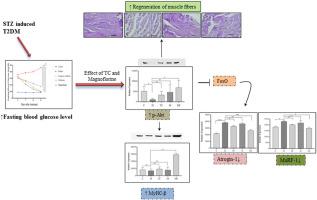Journal of Ethnopharmacology ( IF 4.8 ) Pub Date : 2020-10-24 , DOI: 10.1016/j.jep.2020.113510 Aarti Yadav 1 , Ajay Singh 1 , Jatin Phogat 1 , Anil Dahuja 2 , Rajesh Dabur 1

|
Ethnopharmacological relevance
Tinospora cordifolia (TC) is being used as a blood purifier in Ayurveda since ancient time. It is a very popular immunomodulator and holds anti-inflammatory and anti-oxidative potential, hence anti-aging properties. Therefore, it is also known as ‘Amrita’ in Ayurveda and is widely used to treat diabetes mellitus type II (T2DM) and its secondary complications; however, its underlying mechanism was not expedited to date.
Aim-
To explore the in vivo therapeutic efficiency and mechanism of action of TC and its secondary constitute magnoflorine on the skeletal muscle atrophy in the rat model of T2DM.
Method
Animal model of T2DM was developed using streptozotocin (STZ) injection followed by intervention with TC, metformin, and magnoflorine for three weeks. Confirmation of T2DM and abrogation of atrophic markers and possible mechanisms on supplementation of TC and magnoflorine were explored using histology, bio-assays, Western blotting, and q-PCR.
Result
TC and Magnoflorine supplementations significantly (p<0.05) decreased the fasting blood glucose (FBG) levels in T2DM rats. Both treatments prevented the lean body, individual skeletal muscle mass, and myotubes diameter loss (p<0.05). Magnoflorine significantly reduced the degradation of the protein indicated by biochemical markers of atrophy i.e. decreased serum creatine kinase (CK) levels and increased myosin heavy chain-β (MyHC-β) levels in muscles. Q-PCR and western blotting supported the findings that magnoflorine significantly increased the mRNA and protein abundances (∼3 fold) of MyHC-β.TC and magnoflorine efficiently decreased the expression of ubiquitin-proteasomal E3-ligases (Fn-14/TWEAK, MuRF1, and Atrogin1), autophagy (Bcl-2/LC3B), and caspase related genes along with calpains activities in T2DM rats. Both TC and magnoflorine also increased the activity of superoxide dismutase, GSH-Px, decreased the activities of β-glucuronidase, LPO, and prevented any alteration in the catalase activity. In contrast, magnoflorine increased expression of TNF-α and IL-6 whereas TC and metformin efficiently decreased the levels of these pro-inflammatory cytokines (p<0.05). However, magnoflorine was found to increase phosphorylation of Akt more efficiently than TC and metformin.
Conclusion
TC, and magnoflorine are found to be effective to control fasting blood glucose levels significantly in T2DM rats. It also promoted the Akt phosphorylation, suppressed autophagy and proteolysis that might be related to blood glucose-lowering efficacy of magnoflorine and TC. However, increased muscle weight, specifically of the soleus muscle, expression of IL-6, and slow MyHC indicated the increased myogenesis in response to magnoflorine and independent from its hypoglycemic activity.
中文翻译:

Magnoflorine 通过 Akt/mTOR/FoxO 信号通路预防骨骼肌萎缩,并增加链脲佐菌素诱导的糖尿病大鼠中慢速 MyHC 的产生
民族药理学相关性
自古以来,心叶青牛胆(TC) 在阿育吠陀中就被用作血液净化剂。它是一种非常流行的免疫调节剂,具有抗炎和抗氧化潜力,因此具有抗衰老特性。因此,它在阿育吠陀中也被称为“Amrita”,广泛用于治疗II型糖尿病(T2DM)及其继发并发症;然而,其基本机制迄今尚未加快。
目的-
探讨TC及其次要成分木兰花碱对2型糖尿病大鼠模型骨骼肌萎缩的体内治疗效果及作用机制。
方法
使用链脲佐菌素 (STZ) 注射建立 T2DM 动物模型,然后用 TC、二甲双胍和木兰花碱干预三周。使用组织学、生物测定、蛋白质印迹和 q-PCR 来探索 T2DM 的确认和萎缩标记的消除以及补充 TC 和木兰花碱的可能机制。
结果
TC 和 Magnoflorine 补充剂显着 (p < 0.05) 降低了 T2DM 大鼠的空腹血糖 (FBG) 水平。两种治疗均可防止瘦身、个体骨骼肌质量和肌管直径损失(p < 0.05)。 Magnoflorine 显着减少了萎缩生化标志物所指示的蛋白质降解,即降低了血清肌酸激酶 (CK) 水平并增加了肌肉中的肌球蛋白重链-β (MyHC-β) 水平。 Q-PCR 和蛋白质印迹支持以下发现:木兰花碱显着增加 MyHC-β.TC 的 mRNA 和蛋白质丰度(〜3 倍),并且木兰花碱有效降低泛素蛋白酶体 E3 连接酶(Fn-14/TWEAK、MuRF1)的表达、Atrogin1)、自噬 (Bcl-2/LC3B) 和 caspase 相关基因以及 T2DM 大鼠中的钙蛋白酶活性。 TC 和木兰花碱还可以增加超氧化物歧化酶 (GSH-Px) 的活性,降低 β-葡萄糖醛酸酶 (LPO) 的活性,并防止过氧化氢酶活性的任何改变。相反,木兰花碱增加了 TNF-α 和 IL-6 的表达,而 TC 和二甲双胍有效降低了这些促炎细胞因子的水平 (p < 0.05)。然而,木兰花碱被发现比 TC 和二甲双胍更有效地增加 Akt 的磷酸化。
结论
研究发现 TC 和木兰花碱可有效控制 T2DM 大鼠的空腹血糖水平。它还促进 Akt 磷酸化,抑制自噬和蛋白水解,这可能与木兰花碱和 TC 的降血糖功效有关。然而,肌肉重量(特别是比目鱼肌)的增加、IL-6 的表达和 MyHC 的减慢表明,木兰花碱导致肌生成增加,并且与其降血糖活性无关。


















































 京公网安备 11010802027423号
京公网安备 11010802027423号